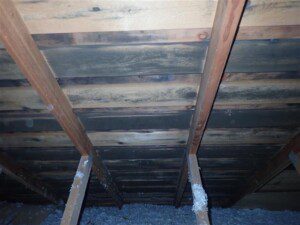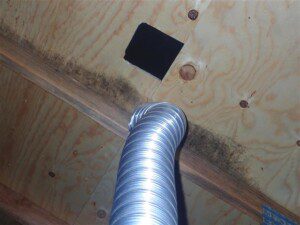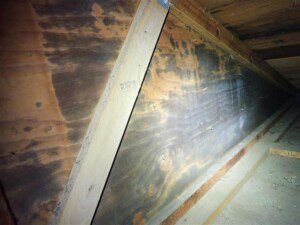
So, what causes attic mold? The accumulation of condensation being trapped in the attic is a gateway for mold growth. This issue can be exacerbated or caused by a lack of proper attic ventilation, improperly vented combustion appliances, improperly vented exhaust vents, damaged or poorly installed gutters/downspouts, and roof leaks.
The approximate rule of thumb for attic ventilation is 1.5 sq. ft. of vent area for every 300 sq. ft. of attic floor. Ventilation should be equally divided amount vents low and high on the roof (intake and exhaust vents). Lack of proper ventilation can trap condensation and lead to mold growth.
HVAC ducts in the attic space can lead to elevated moisture levels when warm, humid air meets the colder surfaces of the ductwork. Improperly sealed or leaking ductwork can cause even higher levels of condensation. Ensuring that HVAC ducts are properly sealed and insulated will help to reduce unwanted condensation.

Exterior moisture issues can also lead to elevated moisture levels and mold growth within the attic space. Clogged downspouts and clogged or improperly sloped gutters can cause gutters to overflow. Overflowing water in the gutters can make its way to the roof line and seep up into the roof sheathing through capillary action. Gutters and downspouts should be continually monitored and cleaned to ensure proper drainage and to prevent moisture from entering the home.
Mold growth caused by elevated moisture levels can be a potential health concern. There are a variety of health issues that can be a direct result of mold in the attic, including:
“In 2004 the Institute of Medicine (IOM) found there was sufficient evidence to link indoor exposure to mold with upper respiratory tract symptoms, cough, and wheeze in otherwise healthy people.” (CDC) These issues are intensified for people with underlying health issues.
You may think that because the mold is in your attic it will not make its way into the living portions of your home. However, mold spores can make their way through extremely small openings between the attic and the home. Therefore, mold growth in the attic can directly affect the home’s occupants.
Please note that the identification of mold in a home is specifically exempted from home inspector responsibilities by state law in Oregon and Washington. A home inspector might mention the possibility of a mold-like substance in the home, but confirming the presence and type of mold present in a home would require laboratory analysis. If you suspect that mold is present in your attic you should consult with a qualified mold remediation company to perform further testing and to make the necessary repairs in order to help protect your home and family.

